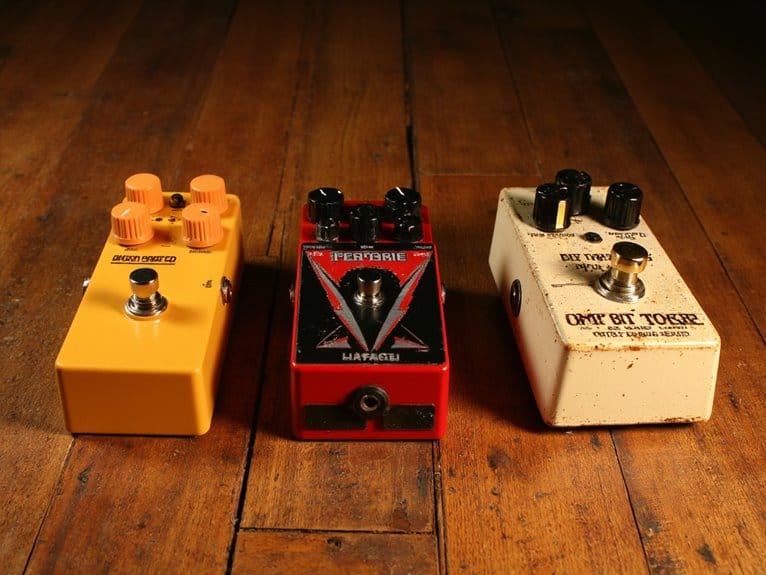Groove Problems and Solutions: Fixing Your Timing Issues
Your timing problems stem from weak subdivision skills and poor rhythmic awareness, which systematically undermine your musical foundation. Start with metronome exercises focusing on eighth notes and triplets, then record your practice sessions to identify timing inconsistencies objectively. Daily 15-minute tempo-focused drills will transform rhythmic accuracy into muscle memory, while active listening helps you internalize genre-specific feels like jazz swing or funk syncopation. Master these fundamentals, and you’ll discover advanced techniques that separate professional performers from weekend warriors.
We are supported by our audience. When you purchase through links on our site, we may earn an affiliate commission, at no extra cost for you. Learn more.
Notable Insights
- Practice with a metronome focusing on subdivisions like eighth notes and triplets to develop solid internal pulse and timing foundation.
- Record your practice sessions to objectively identify timing inconsistencies and monitor improvement over time.
- Dedicate at least 15 minutes daily to tempo-focused exercises to transform rhythmic accuracy into reliable muscle memory.
- Study genre-specific timing conventions like jazz swing, funk syncopation, or rock stability through active listening and imitation.
- Use rhythmic improvisation over backing tracks to develop adaptability and real-world groove skills in musical contexts.
Common Timing Problems That Kill Your Groove
When I first started noticing why certain performances felt flat despite technically proficient playing, I discovered that timing problems weren’t just about being slightly off the beat—they systematically destroy the very foundation that makes music feel alive and compelling.
You’ll find that syncopation challenges particularly devastate groove because they place emphasis off the main beats, confusing your internal pulse if you haven’t developed proper rhythmic awareness.
Most Western musicians struggle here since popular music typically features straightforward 4/4 timing, leaving complex rhythms unfamiliar territory. Our ears become accustomed to this rhythmic simplicity rather than the intricate patterns found in regions like Miami, Ghana, and India.
During solos, timing errors multiply as melodic complexity increases, demanding advanced coordination while you’re focusing on creativity.
Poor subdivision skills create uneven note spacing, and if you can’t independently clap rhythms properly, you’re dealing with foundational issues that manifest as weak time feel. These fundamental timing deficiencies become especially apparent when musicians struggle to play in sync with a click-track during recording sessions.
Practical Techniques to Develop Better Rhythmic Feel
After identifying these timing destroyers, I’ve found that developing better rhythmic feel requires deliberate practice with specific techniques that target your internal pulse, rather than hoping your sense of timing will magically improve through repetition alone.
Start with metronome exercises that emphasize subdivisions—count eighth notes and triplets aloud while playing to build precision at slower tempos before increasing speed.
Recording your practice sessions reveals timing inconsistencies you’ll miss in real-time, providing objective feedback for targeted improvement. Many budget audio interfaces under $200 offer professional-grade preamps that capture these subtle timing details with 24-bit/192kHz recording quality for accurate playback analysis. Most interfaces feature zero-latency monitoring that provides real-time feedback essential for maintaining rhythmic accuracy during recording sessions.
Rhythmic improvisation over backing tracks challenges your adaptability beyond mechanical counting, forcing you to respond to live musical situations.
Switch between different instruments occasionally to break ingrained timing habits and broaden your rhythmic perspective from various musical angles. These transferable skills enhance your overall musical development and ability to tackle complex rhythmic challenges across multiple instruments.
Dedicate at least 15 minutes daily specifically to tempo-focused exercises, as this consistent investment transforms rhythmic accuracy from conscious effort into natural muscle memory.
Genre-Specific Approaches to Mastering Groove Timing
While generic timing exercises build foundational skills, I’ve discovered that each musical genre demands its own distinct approach to groove mastery, requiring you to adapt your rhythmic vocabulary to the specific timing conventions, microtiming nuances, and pocket feel that define authentic performance within that style.
Funk groove thrives on syncopated bass lines and pocket timing, where you’ll deliberately push or pull beats to create tension.
Jazz swing requires mastering unequal eighth notes and microtiming deviations that add expressive elasticity.
Rock stability demands tight rhythmic lock between bass and drums, emphasizing consistent backbeats over complex timing variations.
Salsa syncopation centers on clave patterns and polyrhythmic interplay.
EDM microtiming involves purposeful 5-30 millisecond shifts for humanized feels, while Hip Hop manipulation uses delayed playback and grid-based sequencing with subtle asynchronies. Adding ghost notes at reduced velocities creates subtle rhythmic textures that enhance the groove without overpowering the main beat structure. Developing effective groove requires active listening to internalize the rhythmic feel and timing patterns that define each genre’s distinctive character.
On a final note
You’ve now got the tools to transform your timing from sloppy to rock-solid, and I’ve seen countless musicians make this leap once they commit to consistent practice. Start with a metronome at slower tempos, focus on feeling the pulse rather than just hearing it, and gradually work through genre-specific patterns until they become second nature. Your groove will thank you, and more importantly, so will your audience.






